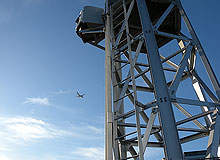
Ten years ago, a titanium strip measuring only 40cm in length, burst the tyre of an Air France Concorde, which subsequently ruptured one of the aircraft’s fuel tanks causing a fire that tragically killed more than a hundred people onboard the flight. That relatively small piece of metal also proved to be the beginning of the end for the Concorde, which several years later was pushed into retirement.
Several more minor incidents have been caused by FOD on runways in recent years – a Biman Bangladesh Airlines flight crashing in Dubai in 2007 and a similar incident on a Kalitta Air aircraft in 2008 again highlight the need to protect runways from FOD. Yet today, only six automatic FOD prevention systems have been fully installed worldwide and just a few other locations are trialling the technology. Adoption of technology to counter the risks of FOD has, to date, been noticeably slow and it’s not due to a lack of solutions on the market.
Although runway scanners cannot prevent debris from getting on to the runway, they are an essential method for locating debris once it is present on the runway. Whether through radar, optical cameras or sensors, the systems on today’s market are able to offer continuous surveillance of a runway rather than rely on intermediate runway inspections. Iain McCreary, managing director of Insight SRI, has recently finished a report analysing the risks posed by FOD on runways and says he believes the industry could be doing more.
“The bottom line is that airports have choices. All of the systems [on today’s market] detect roughly the same debris, and remember not to fall into the trap of looking for the smallest objects possible. The safety risk comes from the larger items,” McCreary says.
FOD for thought
As airports worldwide continue to increase the number of aircraft movements, the requirement to inspect runways for FOD is too growing in importance. The current four-per-day runway inspection standard was introduced as long ago as 1944 when the busiest airport in the world, Chicago, handled just 10-15 aircraft movements every six hours.
Today airports in Europe handle hundred of aircraft movements every six hours, yet still continue with the same number of runway inspections, while in the US, FOD checks have been reduced to just one inspection a day.
“Airports near landfills, constructions sites and the like, are all slightly more vulnerable to FOD incidents, but, generally, the risk has more to do with how well the airport controls FOD throughout the Airport Operations Area (AOA) rather than being runway specific,” McCreary says.
“Development has been slow and the problem lies in airline awareness. Most airlines are, from a financial perspective, rather poorly run. The issues are management culture and weak financial accounting.”
Scanning for success
As the undisputed market leader in the FOD prevention field, QinetiQ became the first company to install automatic FOD detection systems at airports when it introduced Tarsier in 2007. The technology has since been adopted by four airports worldwide – London Heathrow, Vancouver, Dubai and Doha International – and one airbase; the UK’s RAF Boscombe Down. Using high-frequency, high-resolution radars, Tarsier continuously sweeps a runway for hazardous objects and, upon detection, uses integrated day and night camera zooms to identify the item. With a radar range of up to 1km, Tarsier requires two to three units for coverage of an international runway.
For those airports which have become early adopters of the technology, the benefits are already starting to show. At Vancouver International Airport, for example, Tarsier detected a steel grounding wire on one of the runways, which, had it been left undetected, may have caused a major incident. Meanwhile in London, British Airports Authority (owners of Heathrow International) recently held a global conference dedicated to FOD management, featuring a session on the Tarsier system. The conference attracted leading regulators, airlines and airport executives – all of which were keen to get an insight into the benefits of automatic FOD detection.
QinetiQ’s business development director Dr Walker explains that while all airports are at risk from FOD, the type of FOD can vary from location to location. “A solution design is carried out at the airport to jointly determine what the real needs are and how the system should be situated to achieve the best results,” says Walker.
“All airports are at risk from potentially hazardous FOD, such as misplaced tools, aircraft parts and tyre debris. Without an automatic FOD detection system, airports can be at risk from FOD on the runway in between inspections; a continuous runway inspection significantly reduces this risk and, in turn, the risk of a potentially serious incident.”
QinetiQ is soon to launch a new ‘Toolbox’ to support Tarsier. This data management tool will enable Tarsier users to store, analyse and report on all detection data provided by the system.
Airports will be able to use the Toolbox to identify their FOD trends and patterns. The system features an instant reporting function and a heat map that highlights areas which experience strong levels of FOD.
Overall, QinetiQ believes the demand for FOD protection on runways is only going to increase, as regulatory bodies worldwide begin offering greater guidance on the risks and the prevention methods now available. “Regulators are realising the dangers surrounding FOD on runways and are becoming more proactive in encouraging the implementation of automatic FOD detection systems. The Federal Aviation Authority (FAA) has released two advisory circulars to North American airports on the merits of automatic FOD detection equipment, as well as guidance on FOD management programmes. European regulatory working groups have also produced guidance papers, one of which has been submitted to the International Civil Aviation Organization (ICAO),” Walker says.



